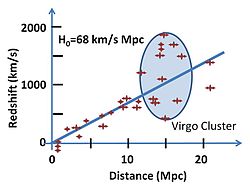 |
| Cepheid stars, maybe not the ones that Hubble used. Courtesy of Cepheid stars from galaxy, Zwicky 18 (Hubble telescope image) |
The story started with Albert Einstein and Edwin Hubble. Einstein has just published his Theory of General Relativity (1916). What follows is Einstein's self-proclaimed 'biggest blunder'. He believed that the universe was static(fixed size) so he added a cosmological constant, Λ into his field equation of the universe since his original equation showed that the universe was expanding. There was no observational evidence for expansion at that time.
... and Hubble finished measuring the speed of Cepheid stars moving away from our galaxy, the Milky Way a few years later. This means that our universe is slowing expanding. This means that there was no need of a Λ term.
 |
| Einstein's field equation |
Hubble changed the way we look at the universe. He found other galaxies besides our own (1922). More importantly, from his observations, he found out that the universe was expanding at a constant rate (1929). There was a beginning to the universe which we now call the Big Bang. To the right is Hubble's plots of the the speed of stars moving away from us. You can see that the further the star from us, the faster it moves away from us.
 |
| Fit of redshift velocities to Hubble's law; patterned after William C. Keel (2007). The Road to Galaxy Formation. Berlin: Springer published in association with Praxis Pub., Chichester, UK. |
Later in the 1990s, two research groups (High-z Supernova and Supernova Cosmology) looking at supernovae (Type 1a) found out that the universe not only expanded at a constant rate, but actually accelerated.
It was generally assumed that the expansion rate would slow over time as gravity pulled the universe back together. The two groups above that used supernovae to study more were astonished when they added their new data points to the Hubble diagram. The universe not only did not slow down expanding but actually expanded even faster. In the plot below, if the universe were expanding at a constant rate, all the points in the lower plot would lie in a straight horizontal line at zero. Instead, the supernovae with higher velocities lie above the line.
 |
| This was the first evidence that the universe is expanding at an accelerated rate, driven by something we choose to call "dark energy". Courtesy of the High-Z Supernova Search Team |




No comments:
Post a Comment